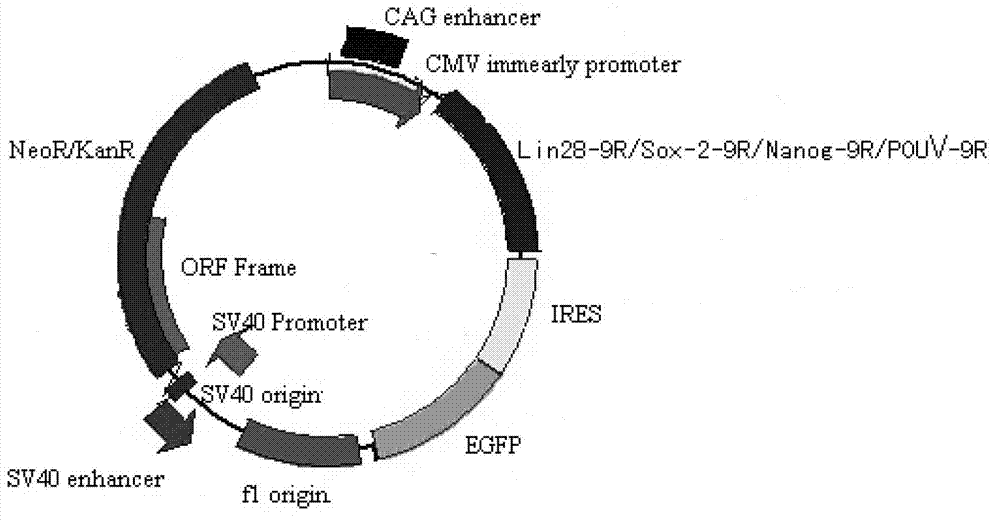Embryonic stem cell culture medium and application thereof
A technology for embryonic stem cells and culture medium, applied in the field of embryonic stem cell culture medium, can solve the problems of unrepeatable experimental results, difficulty in obtaining mouse embryonic stem cell effects, slow growth, etc.
- Summary
- Abstract
- Description
- Claims
- Application Information
AI Technical Summary
Problems solved by technology
Method used
Image
Examples
Embodiment 1
[0068] Embodiment 1, the preparation of recombinant plasmid
[0069] 1. Preparation of recombinant plasmid pGSPF9R-IRES-EGFP
[0070] Using the pIRES2-EGFP vector as the backbone vector, insert the coding gene of the chicken growth hormone signal peptide between its NheI and BglII restriction sites (the chicken growth hormone signal peptide is shown in sequence 1 of the sequence listing, and its coding gene is shown in the sequence listing shown in sequence 2 of the SmaI and BamHI restriction sites, the gene encoding the short arginine peptide is inserted between the restriction sites of SmaI and BamHI (the arginine short peptide is shown in sequence 3 of the sequence listing, and the coding gene is shown in sequence 4 of the sequence listing shown; abbreviated as 9×Arg), the recombinant plasmid pGSPF9R-IRES-EGFP was obtained. In the recombinant plasmid pGSPF9R-IRES-EGFP, there is a multiple cloning site between the coding gene of the chicken growth hormone signal peptide and...
Embodiment 2
[0080] Embodiment 2, preparation of embryonic stem cell subculture medium
[0081] One. The protein expression plasmids prepared in steps 2 to 5 of Example 1 were carried out as follows:
[0082] 1. Transfect the protein expression plasmid by calcium phosphate transfection method (references describing the calcium phosphate transfection method: NANCY HSIUNG, RAYMOND S. ROGINSKI, PAULA HENTHORN, OLIVER SMITHIES, RAJU KUCHERLAPATI, AND ARTHUR I. SKOULTCHI, Introduction and expression of a fetal human globin gene in mouse fibroblasts, MOLECULAR AND CELLULAR BIOLOGY, Apr.1982, p.401-411) was introduced into 293FT cells, and cells expressing EGFP were screened out by observing the fluorescence intensity after 72 hours.
[0083] 2. Culture the cells screened in step 1 at 37°C for 12 hours, and collect the cells by centrifugation;
[0084] 3. Ultrasonicize the cells collected in step 2 (450Hz, 7s and 9s off each time, 44 times), and then use a protein concentration column (Millipore...
Embodiment 3
[0098] Embodiment 3, the cultivation of chicken embryonic stem cells
[0099] 1. Acquisition of blastodisc cells
[0100] Choose freshly hatched eggs (Shouguang chicken) and get blastodisc cells.
[0101] 2. Culture of blastodisc cells
[0102] 1. Experimental group
[0103] Use the chicken embryonic stem cell subculture medium prepared in step 2 of Example 2 to culture blastodisc cells (P0 generation), observe the cell shape, and when the cells appear dense mountain-shaped cell clumps, digest and replace half of the new chicken embryonic stem cell subculture The base was subcultured to obtain the P1 generation. The above-mentioned method was adopted to continue to pass generations, followed by P2 generation, P3 generation, P4 generation, P5 generation, P6 generation, and P7 generation.
[0104] 2. Control group A
[0105] The experiment in Step 1 was carried out by using the control subculture medium A prepared in step 3 of Example 2 instead of the chicken embryonic stem...
PUM
 Login to View More
Login to View More Abstract
Description
Claims
Application Information
 Login to View More
Login to View More - R&D
- Intellectual Property
- Life Sciences
- Materials
- Tech Scout
- Unparalleled Data Quality
- Higher Quality Content
- 60% Fewer Hallucinations
Browse by: Latest US Patents, China's latest patents, Technical Efficacy Thesaurus, Application Domain, Technology Topic, Popular Technical Reports.
© 2025 PatSnap. All rights reserved.Legal|Privacy policy|Modern Slavery Act Transparency Statement|Sitemap|About US| Contact US: help@patsnap.com



